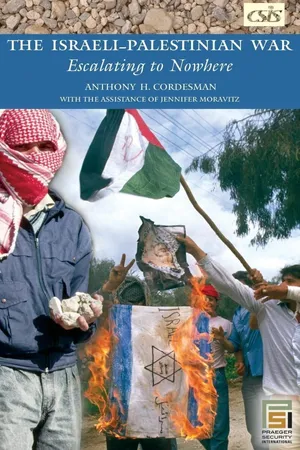
- 563 pages
- English
- PDF
- Available on iOS & Android
About this book
The Israeli-Palestinian conflict is more than a local or regional dispute. Its ongoing and escalating nature increases the risk that the violence will spill over its present borders and contribute to both extremism and terrorism. While the Intifada from 1987 to 1993 was largely a popular uprising and a political struggle, the recent clash is a war with a steady escalation between conventional and unconventional forces. It is in the interest of all major powers, the international community, and the United Nations to press both sides to accept a realistic peace plan. Noted Middle East expert Anthony Cordesman details this continuing struggle by explaining the issues at stake for each side; the various combatants (both directly and indirectly engaged); as well as the course of the war in its various incarnations. The situation on the ground is complex and the quest for peace is ever more uncertain. If the Intifada was a struggle for recognition that a peace had to be reached that was just for both sides, the Israeli-Palestinian War has polarized both sides away from peace, convincing them of the justice of their own cause and tactics and the fundamental injustice of the other side's tactics and goals. Each side has used human rights, international law, and civilian casualties as political weapons. The history of a near century of conflict is used to justify war rather than a search for peace.
Frequently asked questions
- Essential is ideal for learners and professionals who enjoy exploring a wide range of subjects. Access the Essential Library with 800,000+ trusted titles and best-sellers across business, personal growth, and the humanities. Includes unlimited reading time and Standard Read Aloud voice.
- Complete: Perfect for advanced learners and researchers needing full, unrestricted access. Unlock 1.4M+ books across hundreds of subjects, including academic and specialized titles. The Complete Plan also includes advanced features like Premium Read Aloud and Research Assistant.
Please note we cannot support devices running on iOS 13 and Android 7 or earlier. Learn more about using the app.
Information
Table of contents
- CONTENTS
- TABLES AND FIGURES
- INTRODUCTION
- I. FROM PEACE TO WAR: LAND FOR PEACE OR SETTLEMENTS FOR WAR?
- 2. FROM PEACE TO WAR: TERRORISM FOR SETTLEMENTS
- 3. THE FINAL SETTLEMENT ISSUES: ASYMMETRIC VALUES & ASYMMETRIC WARFARE
- 4. THE COLLAPSE OF THE PEACE PROCESS
- 5. THE ACTORS IN THE CONFLICT: THE ISRAELI DEFENSE FORCES
- 6. THE ACTORS IN THE CONFLICT: THE PALESTINIAN FACTIONS ALIGNED WITH THE PALESTINIAN AUTHORITY
- 7. THE ACTORS IN THE CONFLICT: THE PALESTINIAN FACTIONS THAT CHALLENGE PEACE AND THE PALESTINIAN AUTHORITY
- 8. THE OUTSIDE ACTORS THAT HAVE SHAPED THE ISRAELI-PALESTINIAN CONFLICT
- 9. A FAILED PEACE BECOMES OPEN WAR
- 10. CASUALTY TRENDS AND THE COSTS OF THE WAR
- 11. ISRAELI STRATEGY AND TACTICS: ISOLATION, CONTAINMENT, AND THE SELECTIVE USE OF CONVENTIONAL MILITARY POWER
- 12. THE PALESTINIAN RESPONSE: THE BATTLE FOR PUBLIC OPINION AND THE CHALLENGE OF REFORMING THE PALESTINIAN AUTHORITY
- 13. THE COURSE OF THE CONFLICT IN GAZA
- 14. THE COURSE OF THE CONFLICT IN THE WEST BANK AND GREATER JERUSALEM
- 15. CONFLICT IN ISRAEL PROPER
- 16. THE CONTINUING HOPE FOR PEACE: THE QUARTET AND THE "ROAD MAP"
- NOTES